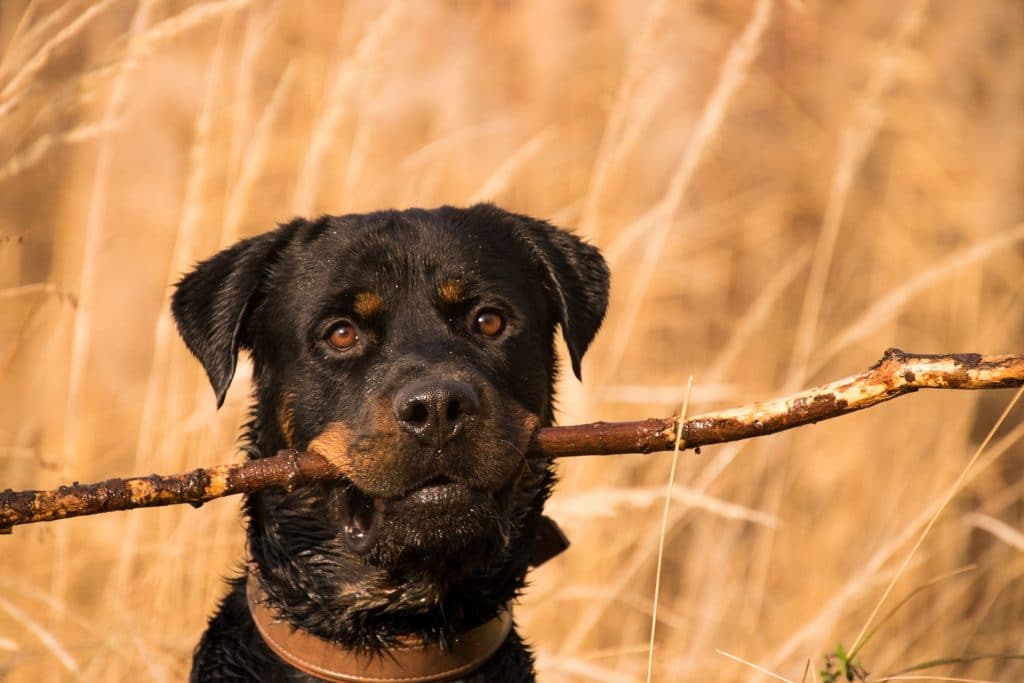Often misunderstood, the Rottweiler is an intelligent, curious, and confident breed that fiercely loves its family, and thrives in environments that offer stability and consistency in training, and plenty of love and affection in everyday life. This unique breed that has done everything from pull butcher’s carts to embark on search-and-rescue missions, has a colorful and interesting past, and so much still to offer in the present.

Is a Rottweiler the right kind of dog for you? There are a lot of things to consider when adding a dog to your life, so we’ve covered just about everything you’ll need to know in this in-depth breed profile.
Breed Characteristics
Key
- Low
- Medium
- High
- Origin: Germany
- Size:
- Weight: 85-130 pounds
- Activity level:
- Barking/howling level:
- Good with dogs: yes
- Good with kids: yes
- Good with cats:
- Shedding:
- Grooming level:
- Training level:
Rottweiler Appearance
Rottweiler are bold and beautiful, with a short black double coat, and markings that range from rust to mahogany in color. Those markings are generally over the eyes, on the cheeks, on the sides of the muzzle, on the chest and legs, and under the tail.
They are a large and muscular breed, with male Rottweilers growing up to 27 inches tall and weighing up to 130 pounds, and females measuring up to 25 inches and weighing up to 115 pounds. But despite their muscular, broad-chested bodies and dramatic coloring, these dogs also have a softer side – you just need to take one look into their warm, dark brown eyes to understand that.
Rottweiler Personality
Rotweilers are known for their confident and courageous personalities – which is why their roles as search-and-rescue assistants and police dogs have always been a good fit. Though they aren’t as friendly or quick to cuddle strangers as some other breeds, they are affectionate and loving to the people in their lives that they’re close to. The want to protect the ones they care about (and their house, property, etc.), and they adore having a job to do.
This breed isn’t an overly excitable dog, but they’re smart and highly trainable, which means they’ll adore games and activities that challenge them mentally and physically.
Ideal Environment for a Rottweiler
Because of their size and demeanor, these dogs tend to do best in bigger spaces, especially in places with a fenced yard.
They’re fine living with other animals if they’re raised with them, but introducing strange dogs or cats to them doesn’t always go smoothly, so you’ll need to be prepared for those situations. They can also be good with children (especially if raised with them), though because of their size, they may knock very little ones over, or even try to herd them. As with most breeds, it’s important to supervise the dogs and kids when they’re together.
Ideal Human for a Rottweiler
Though Rottweilers can be loving and affectionate, they also are strong-minded and physically strong – which means they aren’t the best match for a first time dog owner. Their perfect person would be someone who is firm but fair, and someone who has the time and energy to invest in their training and socialization. And of course someone who has lots of love and affection to offer them – because they will get it in return.
Rottweiler Dog Training
Though Rottweilers can make wonderful companions, they are not a great fit for every situation or household. For a Rottie to truly thrive, they must have a human who is dedicated to training them, socializing them, and helping them become the best version of themselves. Since they are often pre-judged by people, and sometimes even considered a “dangerous” breed, it’s essential to show just how trainable, affectionate, and wonderful these dogs can actually be.
Training a Rottweiler is essential, and they require a firm and consistent hand – which means this breed is not a great fit for a novice, or a trepidatious dog owner. You never want to be harsh with this breed, but you do want to be assertive when training them. Rottweilers also get bored easily (which can lead to destructive behavior), so it’s essential to keep them mentally and physically stimulated – through games, activities, or by giving them a job to do.
Most importantly, by taking the time to socialize and train this breed, you’ll make them feel comfortable and safe with you as they explore the world, and they’ll gain the confidence to be the well-adjusted, well-behaved pup you know that they can be. Above all this breed really just wants to please their loved ones, and their smarts and charm mean that any effort you put into training them will be well worth it.
Rottweiler Grooming
When it comes to grooming, Rottweilers are a fairly low-maintenance breed. You’ll generally just need to brush them weekly with a firm bristle brush, which will help get rid of the dead hair in their coat and keep their skin healthy and clean. Brushing frequently will also help keep your house’s hair accumulation under control, especially during the two times a year that they shed their coat.
Rotweilers don’t need to be bathed frequently – but don’t be afraid to soap them up if they’re getting a little stinky. Speaking of stinky, you’re also going to want to brush their teeth a few times a week to keep that breath minty fresh, and to remove tartar buildup.
Rottweiler Health
Though this is a generally healthy breed, there are a few health issues these pups sometimes encounter including hip dysplasia, bone cancer, bloat, and various allergies.
Rottweilers usually live from 8 to 11 years, and with the proper exercise, food, and regular trips to the vet, your pup will have a good chance at a long and happy life.
Rottweiler Breed History
Rottweilers, descendants of Roman Molossus dogs, were originally bred to drive cattle to market for butchering in the German town of Rottweil. They were also used for protection against bandits and rustlers along the way, and to pull carts of meat for butchers – which earned them the nickname “Butcher’s Dog of Rottweil”.
Once they were replaced by cattle cars, Rottweilers were then put to use as police dogs and personal security, and were even one of the first breeds used as guide dogs for the blind. To this day they are talented search-and-rescue dogs. They were recognized as a breed by the American Kennel Club in 1931, and their appearance and character have remained much the same over the last century.
Getting a Rottweiler
Rottweiler breeders
It’s always a good idea to meet the parents of your puppy, and to see how the litter interacts with each other. A good, trustworthy breeder should have records of the parents’ lineage, too and should be able to tell you more about the specific litter.
The American Kennel Club website is a great place to start your search for a reputable breeder. Make sure you wise up on puppy mills and internet scams—following some simple steps can help avoid further funding of this terrible practice, and help you end up with a pet whose breeding and early-life experience will more reliably result in a well-adjusted dog.
Adopting a Rottweiler
As with many breeds, Rottweilers often find their way to rescue centers for a variety of reasons, but often it’s the simple fact that their previous owners simply felt unable to care for them any longer, or that they just aren’t the right fit for that particular household.
A surrendered dog will often already be well trained and simply in need of a new, loving home. You can find rescue centers local to you with a quick internet search. A Rottweiler can make for a wonderful friend and they’re sure to be a source of joy, with plenty of laughs and perhaps a little bit of mischief along the way. So whether you’re planning on adopting or finding a breeder to find a puppy, prepare yourself, your home and your heart to welcome a dog with plenty of personality and energy
Rottweiler
If you’re simply in love with Rottweilers, then you’ll be craving what we’ve got for you next. From everything you need to know about Rottweiler puppies, to reasons why they’re an amazing breed, to the most popular names and more:
